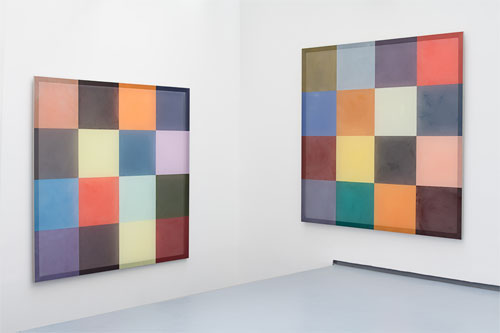BART – VALENTIN
Cecile Bart‘s “screens/paintings” are passages, zones where instantaneous encounters can take place, the crossing of mobile elements. It equates unequatable things: the membrane of the eyes with what lies outside of it, the angular geometry of the frame—that of the screen and that of the architecture—at the touch of the light’s vaporising effect. In this work, perception becomes a new ordination of things and of the world, elaborating in a flirtation, a dance, constantly renewed with the emptiness, the air, the “environment”.
In the dramatic art of the window, Bart has retained from Cézanne’s teachings the desire to “make visible the organising activity of perception”. Here the pictorial world intersects with that of cinema, through the metaphor of the screen as a surface for inscribing, diffracting and delaying a desire that never reaches its object. Whether suspended in empty space or attached to the walls, whether multiplied or isolated, the screens loom up as if to reveal the surrounding space, which they simultaneously concentrate and filter, requiring constant adjustments of the eyes and body. Cecile Bart’s works also play on the obliteration of subjectivity, the painting being applied mechanically, when the sensual materiality of the fabric acts as an epidermis, an architectural over-skin working in terms of lightness, of “flirtation”, but also of the threat of dissolution. From building techniques, her work also borrows matt surfaces, sharp contours and a kind of systematic modularity. The production protocol—a Terylene canvas is coated in paint, then brushed and aired before being stretched on a metallic frame—though repeated over time, constantly replays its effect.
In this exhibition, which could constitute a kind of “chromatic keyboard”, a tension is established between colour and motif through a play of reflections, links and mises en abyme. Arranged into monochromes, chequers or “diagonals”, the colours emphasise, or contrast with, the systematism of the shapes. The tones are derivative or primary, harmonious or dissonant, tough or tender, fast or slow, muted or resonant, modulated according to the blurring and the incidental effect of the light passing through them. Thus off-whites respond to blacks, powder pinks to reds, water greens to industrial blues, orangey shades to Saturn purples. Although it is preferable to see most of Cecile Bart’s works in natural light, this installation fully embraces artificial light, with the sudden changes in chromatic values and the impossibility of inducing the variations it imposes.
In the repetitive play of the mises en abyme, it is pictorial unity and architectural unity that are simultaneously abolished and recreated by the linking activity that the eyes are required to perform. The infrathinness of the translucent fabric communicates with the thickness of the walls and the transparency of the glass roof. When the light falls away, the values invert, the fabric absorbs but no longer reflects the light, leaving the painting to designate itself as a solid, like a layer of cladding, revealing its fixative power. They turn from filters into “masks”.
The size of the frames, generally anthropomorphic, implies grasping the purely optical experience anew in the motivity of the body. Keeping a space between the frame and the wall invests it with a slight levitation. This suggests the impossibility of the work coinciding with its context, but also presents painting as a function, a breathing organ. What occupies this space between the frame and the wall, and makes it possible to build the painting’s reverse angle through a play of projected shadows, is what Deleuze calls “affection”. This beating space acts as a pulse that extends beyond the painting. Through this intercalary operation, the “painting” no longer stands on anything but its cinematic relationship with the eyes—which it captivates, and which in turn bring it to life and temporalise it—inviting them to pass “behind”. Etymologically, the French word for Terylene, Tergal, refers to the “dorsal region”. It is a metaphor that literalises Bart’s work, in its constantly renewed scopic play of masks and screens.
Texte by Clara Guislain
